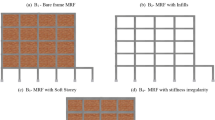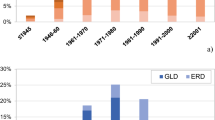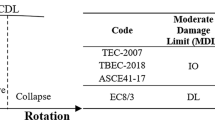Abstract
The present study investigates the vulnerability assessment of the prototype revised Mandatory Rule of Thumb (MRT) buildings initially designed and detailed for three storeys bare frame building; later modified through variable number of storeys (three, four, and five) and different arrangement of infill walls (bare frame, soft-storey, irregular infilled, and fully infilled). The application of infill walls increases the fundamental frequencies, stiffness, and maximum strength capacity, but reduces the deformation capability than the bare frame building. The vulnerability was also reduced through infill walls, where the probability of exceeding partial-collapse and collapse damage reduced by 80% and 50%, respectively. Furthermore, the increased in storeys (three to five) also increases the failure probability, such that partial-collapse and collapse for fully infilled increases by almost 55% and 80%, respectively. All obtained results and discussions concluded that the structural sections and details assigned for MRT building is not sufficient if considered as bare frame and soft-storey. And increase in number of storeys causes building highly vulnerable although the infill walls were considered.
Similar content being viewed by others
References
Mainstone R J. Summary of paper 7360. On the stiffness and strengths of infilled frames. Proceedings of the Institution of Civil Engineers, 1971, 49(2): 230
Mainstone R J. On the Stiffnesses and Strengths of Infilled Frames. Building Research Station, 1974
Zarnic R, Tomazevic M. An experimentally obtained method for evaluation of the behavior of masonry infilled RC frames. In: Proceedings of the 9th World Conference on Earthquake Engineering, 1988, 163–168
Mander J B, Nair B, Wojtkowski K, Ma J. An Experimental Study on the Seismic Performance of Brick-Infilled Steel Frames with and without Retrofit. Technical Report NCEER-93-0001, 1993
Mehrabi A B, Benson Shing P, Schuller M P, Noland J L. Experimental evaluation of masonry-infilled RC frames. Journal of Structural Engineering, 1996, 122(3): 228–237
Crisafulli F J. Seismic behaviour of reinforced concrete structures with masonry infills. Dissertation for the Doctoral Degree. Canterbury: University of Canterbury, 1997
Pinto A, Varum H, Molina J. Experimental assessment and retrofit of full-scale models of existing RC frames. In: Advances in Earthquake Engineering for Urban Risk Reduction. Dordrecht: Springer, 2006, 353–367
Dumaru R, Rodrigues H, Furtado A, Varum H. Seismic vulnerability and parametric study on a bare frame building in nepal. Frontiers in Built Environment, 2016, 2: 31
Chaulagain H. Seismic assessment and retrofitting of existing buildings in Nepal. Dissertation for the Doctoral Degree. Aveiro: University of Aveiro, 2015
Chaulagain H, Rodrigues H, Spacone E, Varum H. Seismic safety assessment of existing masonry infill structures in Nepal. Earthquake Engineering and Engineering Vibration, 2016, 15(2): 251–268
Varum H. Seismic assessment, strengthening and repair of existing buildings. Dissertation for the Doctoral Degree. Aveiro: University of Aveiro, 2003
Holmes M. Steel frames with brickwork and concrete infilling. Proceedings of the Institution of civil Engineers, 1961, 19, 473–478
Holmes M. Combined loading on infilled frames. Proceedings of the Institution of Civil Engineers, 1963, 25(1): 31–38
Bertero V, Brokken S. Infills in seismic resistant building. Journal of Structural Engineering, 1983, 109(6): 1337–1361
Gautam D, Rodrigues H, Bhetwal K K, Neupane P, Sanada Y. Common structural and construction deficiencies of Nepalese buildings. Innovative Infrastructure Solutions, 2016, 1(1): 1–18
Pokharel T, Goldsworthy H. Lessons Learned from the Nepal Earthquake 2015. In: Proceedings of the 10th Pacific Conference on Earthquake Engineering Building an Earthquake Resilient Pacific. Sydney, 2015
Gautam D, Chaulagain H. Structural performance and associated lessons to be learned from world earthquakes in Nepal after 25 April 2015 (M W 7.8) Gorkha earthquake. Engineering Failure Analysis, 2016, 68: 222–243
Nepal G O. Post Disaster Needs Assessment. Sector Reports. 2015
Shakya M, Kawan C K. Reconnaissance based damage survey of buildings in Kathmandu valley: An aftermath of 7.8 Mw, 25 April 2015 Gorkha (Nepal) earthquake. Engineering Failure Analysis, 2016, 59: 161–184
NBC 205:1994. Mandatory Rules of Thumb, Reinforced Concrete Buildings without Masonry Infill. HMG/Ministry of Housing and Physical Planning, Department of Building, Kathmandu, Nepal, 1994
NBC 205:2012. Mandatory Rules of Thumb, Reinforced Concrete Buildings without Masonry Infill. HMG/Ministry of Housing and Physical Planning, Department of Building, Kathmandu, Nepal, 2012
NBC 201:1994. Mandatory Rules of Thumb, Reinforced Concrete Buildings with Masonry Infill. HMG/Ministry of Housing and Physical Planning, Department of Building, Kathmandu, Nepal, 1994
Chaulagain H, Rodrigues H, Jara J, Spacone E, Varum H. Seismic response of current RC buildings in Nepal: A comparative analysis of different design/construction. Engineering Structures, 2013, 49: 284–294
IS1893, B. I. S. Indian Standard criteria for earthquake resistant design of structures (part 1): General provisions and buildings. New Delhi: Bureau of Indian Standards, 2002
NBC 105:1994. Mandatory Rules of Thumb, Reinforced Concrete Buildings without Masonry Infill. HMG/Ministry of Housing and Physical Planning, Department of Building, Kathmandu, Nepal, 1994
Vu-Bac N, Lahmer T, Zhuang X, Nguyen-Thoi T, Rabczuk T. A software framework for probabilistic sensitivity analysis for computationally expensive models. Advances in Engineering Software, 2016, 100: 19–31
Hamdia K M, Silani M, Zhuang X, He P, Rabczuk T. Stochastic analysis of the fracture toughness of polymeric nanoparticle composites using polynomial chaos expansions. International Journal of Fracture, 2017, 206(2): 215–227
Seismosoft. SeismoStruct-A Computer Program for Static and Dynamic Nonlinear Analysis of Framed Structures. 2004
Smyrou E, Blandon C, Antoniou S, Pinho R, Crisafulli F. Implementation and verification of a masonry panel model for nonlinear dynamic analysis of infilled RC frames. Bulletin of Earthquake Engineering, 2011, 9(5): 1519–1534
Rodrigues H, Varum H, Arêde A, Costa A. Comparative efficiency analysis of different nonlinear modelling strategies to simulate the biaxial response of RC columns. Earthquake Engineering and Engineering Vibration, 2012, 11(4): 553–566
Mander J B, Priestley M J, Park R. Theoretical stress-strain model for confined concrete. Journal of Structural Engineering, 1988, 114(8): 1804–1826
Martínez-Rueda J E, Elnashai A. Confined concrete model under cyclic load. Materials and Structures, 1997, 30(3): 139–147
Madas P, Elnashai A. A new passive confinement model for the analysis of concrete structures subjected to cyclic and transient dynamic loading. Earthquake Engineering & Structural Dynamics, 1992, 21(5): 409–431
Menegotto M, Pinto P. Method of analysis for cyclically loaded RC frames including changes in geometry and non-elastic behaviour of elements under combined normal force and bending. In: IABSE Congress Reports of the Working Commission, 1973
Bauschinger J. Variations in the elastic limit of iron and steel. Journal of the Iron and Steel Institute, 1887, 12: 442–444
Furtado A, Rodrigues H, Arêde A, Varum H, Grubišić M, Šipoš T K. Prediction of the earthquake response of a three-storey infilled RC structure. Engineering Structures, 2018, 171: 214–235
Pinho R, Elnashai A. Dynamic collapse testing of a full-scale four storey RC frame. ISET Journal of Earthquake Technology, 2000, 37: 143–163
Rodrigues H, Furtado A, Vila-Pouca N, Varum H, Barbosa A R. Seismic assessment of a school building in Nepal and analysis of retrofitting solutions. International Journal of Civil Engineering, 2018, 16(11): 1573–1589
Varum H, Furtado A, Rodrigues H, Dias-Oliveira J, Vila-Pouca N, Arêde A. Seismic performance of the infill masonry walls and ambient vibration tests after the Ghorka 2015, Nepal earthquake. Bulletin of Earthquake Engineering, 2017, 15(3): 1185–1212
FEMA-273. NEHRP Guidelines for the Seismic Rehabilitation of Buildings. Washington DC: The Agency, 1997
SEAOC. V. Performance Based Seismic Engineering of Buildings. Sacramento: Structural Engineers Association of California, 1995
Rossetto T, Elnashai A. Derivation of vulnerability functions for European-type RC structures based on observational data. Engineering Structures, 2003, 25(10): 1241–1263
Ghobarah A. On drift limits associated with different damage levels. In: International workshop on performance-based seismic design, 2004
Macedo L, Araújo M, Castro J. Assessment and calibration of the Harmony Search algorithm for earthquake record selection. In: Proceedings of the Vienna Congress on Recent Advances in Earthquake Engineering and Structural Dynamics, 2013
Ram T D, Wang G. Probabilistic seismic hazard analysis in Nepal. Earthquake Engineering and Engineering Vibration, 2013, 12(4): 577–586
Shrestha S. Probabilistic seismic hazard analysis of Kathmandu city, Nepal. International Journal of Engineering Research and General Science, 2014, 2(1): 24–33
Subedi B, Parajuli H R. Probabilistic Seismic Hazard Analysis of Nepal. In: Proceedings of IOE Graduate Conference, 2016, 265–270
Author information
Authors and Affiliations
Corresponding author
Rights and permissions
About this article
Cite this article
Dumaru, R., Rodrigues, H. & Varum, H. Seismic fragility assessment of revised MRT buildings considering typical construction changes. Front. Struct. Civ. Eng. 14, 241–266 (2020). https://doi.org/10.1007/s11709-019-0560-4
Received:
Accepted:
Published:
Issue Date:
DOI: https://doi.org/10.1007/s11709-019-0560-4




